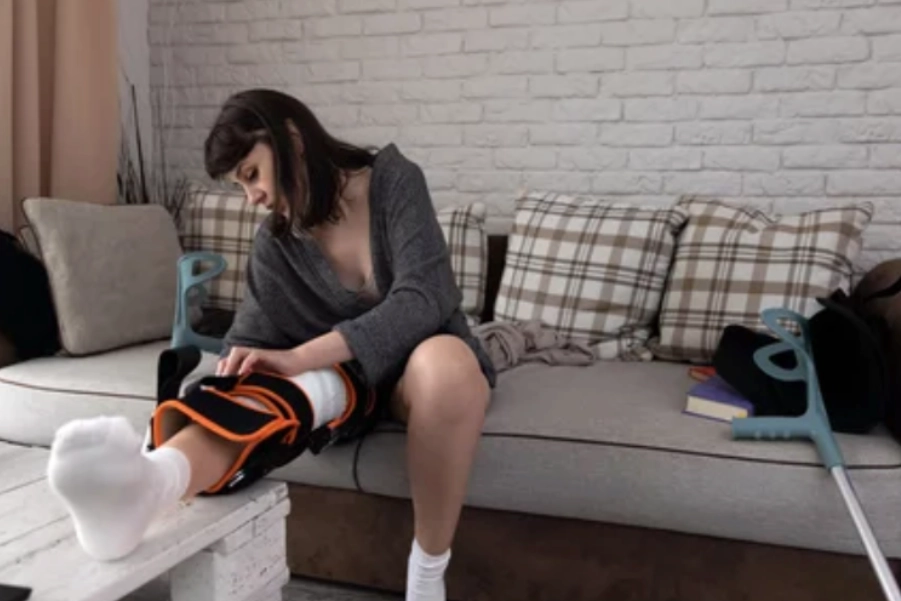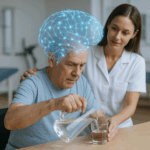Physiotherapy Treatment Protocol for Post-ACL Reconstruction
Overview of Conditions:
Early Rehabilitation (0-6 weeks):
Post-ACL reconstruction (ACLR) aims to restore normal knee function while ensuring the graft heals appropriately. The primary goals during this phase are reducing pain and swelling, protecting the surgical site, maintaining range of motion (ROM), and initiating gentle quadriceps activation. A knee brace is typically used for immobilization, with weight-bearing restrictions based on the surgical protocol.
Late Rehabilitation (6 weeks – 6 months):
In this phase, the focus shifts to regaining strength, functional mobility, and proprioception. The patient starts engaging in more dynamic exercises, emphasizing the quadriceps, hamstrings, and calf muscles. Core stability and dynamic control are also prioritized to prepare for sport-specific activities and prevent re-injury.
Complications:
- Graft failure: Inadequate graft healing or re-tear.
- Loss of ROM: Particularly extension loss due to adhesions or stiffness.
- Patellofemoral pain: Altered mechanics post-surgery.
- Muscle weakness: Quadriceps and hamstring atrophy due to disuse.
- Deep vein thrombosis (DVT): Risk of clot formation, especially in early stages.
Arthritis:
Post-ACL reconstruction patients are at increased risk of developing post-traumatic osteoarthritis (PTOA) due to joint instability and mechanical changes from the surgery. This risk is higher with poor rehabilitation, premature return to high-impact activities, or graft failure.
Assessment and Evaluation:
History:
- Detailed history of the injury and surgery.
- Onset of pain, swelling, or functional limitations post-surgery.
- Issues with graft healing, stability, or re-injury.
- Previous knee injuries or surgeries (e.g., meniscal or cartilage damage).
Physical Examination:
- Pain and Swelling: Use VAS/NPRS to assess pain intensity.
- Range of Motion (ROM): Assess knee flexion and extension, focusing on terminal knee extension.
- Strength Testing: Test quadriceps, hamstrings, and calf strength bilaterally using manual muscle testing or isokinetic testing.
- Gait Analysis: Look for altered gait patterns (e.g., limping or knee valgus).
- Ligamentous Integrity: Assess graft integrity using clinical tests like the Lachman or pivot shift test.
- Functional Tests: Use the Single Leg Hop or Y Balance Test for functional stability assessment.
Goal Setting:
Short-Term Goals (0-6 weeks):
- Pain Reduction: Achieve a reduction in pain and swelling (VAS ≤ 3).
- ROM: Improve knee extension and flexion, aiming for 0-90° ROM.
- Quadriceps Activation: Achieve voluntary quadriceps activation.
- Gait: Normalize gait using crutches if necessary.
Long-Term Goals (6 weeks – 6 months):
- Strengthening: Achieve near-normal strength in the quadriceps and hamstrings compared to the unaffected limb.
- Return to Function: Improve functional mobility, including walking, stair climbing, and squatting.
- Proprioception and Balance: Enhance knee proprioception and dynamic stability to prevent re-injury.
- Return to Sport: Gradual reintroduction to sport-specific activities (only when functional criteria are met).
Recommended Treatment:
Electrotherapy:
- Transcutaneous Electrical Nerve Stimulation (TENS)
- Indication: Pain management and reduction of post-operative inflammation.
- Parameters:
- Frequency: 80-120 Hz
- Pulse Width: 100-300 µs
- Duration: 20-30 minutes, 2-3 times daily
- Mechanism: Modulates pain signals and stimulates endorphin release.
- Interferential Therapy (IFT)
- Indication: Control pain, reduce swelling, and improve tissue healing.
- Parameters:
- Frequency: 4,000 Hz carrier modulated at 80-150 Hz
- Duration: 20-30 minutes per session
- Mechanism: Deeper tissue penetration, promotes muscle relaxation, reduces inflammation.
- Class 4 LASER Therapy
- Indication: Pain control, reduction of inflammation, and tissue healing.
- Parameters:
- Wavelength: 800-900 nm
- Power: 5-10 W
- Duration: 5-10 minutes per application
- Mechanism: Stimulates cellular regeneration and collagen production.
- Ultrasound Therapy
- Indication: Tissue healing, especially post-surgery.
- Parameters:
- Frequency: 1 MHz
- Intensity: 1.0-1.5 W/cm²
- Duration: 8-10 minutes
- Mechanism: Stimulates healing, reduces inflammation, and increases circulation.
Thermotherapy:
- Moist Heat Packs
- Indication: Improve circulation, relax muscle spasms, and alleviate pain.
- Application: Apply for 15-20 minutes before exercises to increase muscle extensibility.
- Mechanism: Enhances blood flow and tissue elasticity, aiding in muscle preparation for movement.
Manual Therapy:
- Joint Mobilization
- Indication: Restore knee joint mobility, especially tibiofemoral and patellofemoral joints.
- Techniques: Grade III or IV mobilizations for pain relief and ROM improvement.
- Mechanism: Reduces stiffness and improves synovial fluid distribution.
- Myofascial Release
- Indication: Relieve tightness in the quadriceps, hamstrings, calves, and hip flexors.
- Technique: Gentle, sustained pressure to release trigger points and tight fascia.
- Mechanism: Reduces muscle tension, improving flexibility and reducing stress on the knee.
Exercise Therapy:
- ROM Exercises
- Exercise: Start with passive, active-assisted, then active ROM exercises focusing on knee extension and flexion.
- Duration: 3-5 sets, 10-15 reps, 2-3 times per day.
- Mechanism: Increases joint mobility, reduces stiffness.
- Strengthening Exercises
- Exercise: Begin quadriceps and hamstring strengthening (e.g., straight leg raises, squats, leg presses).
- Progression: Gradually add resistance as tolerated.
- Duration: 2-3 sets, 10-12 reps, 3 times per week.
- Mechanism: Enhances knee stability, reduces joint loading, prevents re-injury.
- Proprioception and Balance Training
- Exercise: Perform balance exercises on unstable surfaces like wobble boards or foam pads.
- Duration: 2-3 sets, 20-30 seconds per stance, 3 times per week.
- Mechanism: Improves dynamic knee control and joint awareness.
- Functional Training
- Exercise: Begin light functional activities like step-ups, walking, stair climbing.
- Duration: Increase complexity as tolerated.
- Mechanism: Mimics real-life activities, improving the ability to return to daily and sport-specific activities.
Precautions:
- Early Rehabilitation:
Avoid aggressive weight-bearing until the graft has healed sufficiently. Follow the surgeon’s movement restrictions to avoid graft failure. - Pain and Swelling:
Monitor for excessive swelling or pain during exercises. If these occur, decrease intensity and apply ice. - Gait:
Be cautious of abnormal gait patterns; ensure crutches or a brace are used as needed. - Post-Surgical Infections:
Monitor for signs of infection (increased redness, warmth, drainage). Refer immediately if necessary.
Reassessment and Criteria for Progression/Change in Care Plan:
- Pain and Swelling:
If pain or swelling persists after 4-6 weeks, reconsider the rehabilitation approach or consult the surgical team. - ROM:
If knee extension is limited after 6 weeks or flexion is restricted after 12 weeks, refer for further evaluation to avoid complications like scar tissue formation. - Strength and Function:
Ensure the patient achieves 80-90% strength compared to the unaffected side before progressing to dynamic activities. Evaluate functional milestones (e.g., single-leg hops, vertical jump) before considering return to sport.
Note: Treatment options must be selected wisely and appropriately, as per the individual’s specific needs and clinical condition. It is crucial to follow the surgeon’s guidelines and consult with a qualified healthcare provider for personalized treatment and progress assessment.
Disclaimer: The information provided is for educational purposes only and should not be used as a substitute for professional medical advice, diagnosis, or treatment. Always consult with a qualified healthcare provider for your specific condition.
References:
- Manske, R. C., et al. (2021). “Rehabilitation after ACL Reconstruction: A Critical Review.” Journal of Orthopaedic & Sports Physical Therapy, 51(5), 267-280. https://doi.org/10.2519/jospt.2021.10436
- Noyes, F. R., et al. (2022). “The Long-Term Outcomes of ACL Reconstruction: A Review of 20 Years of Research.” American Journal of Sports Medicine, 50(6), 1464-1471. https://doi.org/10.1177/03635465221101747
- Ardern, C. L., et al. (2020). “Progressive Rehabilitation Following ACL Reconstruction.” Physical Therapy Reviews, 25(6), 349-357. https://doi.org/10.1080/10833196.2020.1763407






